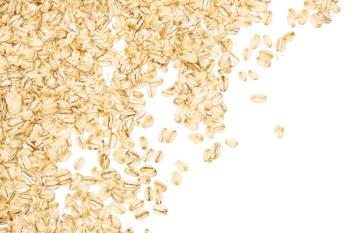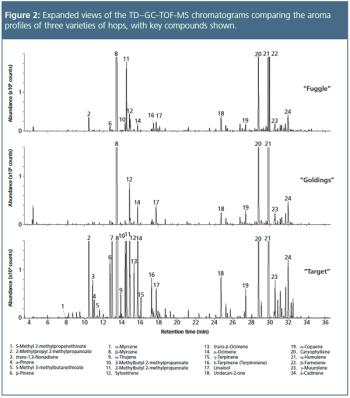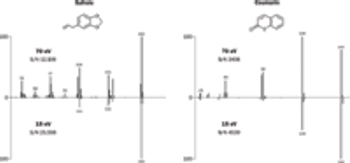Articles by Laura McGregor

Petroleum contamination from leaking underground storage tanks, for example, is a significant concern for both the environment and human health. Thorough characterization of the contamination is required to form appropriate risk assessments and remediation strategies, but until now, the determination of total petroleum hydrocarbons (TPHs) in soil has typically involved a convoluted and labour-intensive process. In this article, the analysis of TPH in environmental media is simplified using flow-modulated GC×GC–FID with quantitation based on pre-defined compound groupings. This approach overcomes the drawbacks of conventional solvent fractionation approaches, by eliminating the need for sample fractionation and automating data processing workflows.

In the testing of six different oat brands, headspace sorptive extraction and comprehensive two-dimensional gas chromatography time-of-flight mass spectrometry (GC×GC–TOF-MS) reveal how various packaging types can affect and alter the oats’ volatile profile, underscoring the potential impact of packaging on food quality.

Petroleum contamination from leaking underground storage tanks, for example, is a significant concern for both the environment and human health. Thorough characterization of the contamination is required to form appropriate risk assessments and remediation strategies, but until now, the determination of total petroleum hydrocarbons (TPHs) in soil has typically involved a convoluted and labour-intensive process. In this article, the analysis of TPH in environmental media is simplified using flow-modulated GC×GC–FID with quantitation based on pre-defined compound groupings. This approach overcomes the drawbacks of conventional solvent fractionation approaches, by eliminating the need for sample fractionation and automating data processing workflows.

Immersive sorptive extraction coupled with comprehensive two-dimensional gas chromatography and time-of-flight mass spectrometry (GC×GC–TOF-MS) was used to compare flavour profiles from popular brand soft drinks with those of imitation products.

Here’s a look back at the exciting research that was presented in a recent e-seminar celebrating women in science.

A TD–GC×GC–TOF-MS method for malodour detection

The benefits that GC×GC–TOF-MS with tandem ionization and chemometrics offer for fragrance profiling and authenticity evaluation.

Laura McGregor, Stefan Koschinski, and Elinor Hughes, SepSolve Analytical Assessing aroma profiles with high-capacity sorptive extraction combined with GC×GC–TOF-MS and powerful data mining software.

There are three main sub-species of cannabis—indica, sativa, and ruderalis—but there are hundreds of commercial strains based on these sub-species and their hybrids. Profiling the terpene content in these strains is vital to provide accurate labelling of cannabis-based products, but it can be very challenging. The usual technique for this—one-dimensional gas chromatography (GC)—is not always reliable when it comes to separating the diverse classes of terpenes. This article illustrates how two-dimensional GC (GC×GC) coupled with mass spectrometry (MS) can be used to profile cannabis terpenes with enhanced separation, resulting in the confident identification of terpenes and improved flavour interpretation.

This proof-of-principle study shows that polymer-based sorptive extraction probes, coupled with secondary focusing by thermal desorption and analysis by flow-modulated GC×GC–TOF-MS/FID, can be used to separate and identify flavour compounds in milk. As well as comparing the profiles of dairy and non-dairy milks, this article highlights the practical benefits of this sampling procedure, the ability of two-dimensional GC to physically separate components that would coelute in one-dimensional GC, and the use of software tools to improve workflow.

This proof-of-principle study shows that dynamic headspace sampling with thermal desorption–gas chromatography–time‑of-flight mass spectrometry (TD–GC–TOF-MS) analysis can be used to investigate the complex aroma profiles released from flavoured cookies. Key flavour compounds in chocolate-chip, peanut, and orange-cream cookies are highlighted, and the effect of raising the headspace extraction temperature is examined.

This article provides a short overview of the theory and practice of the rapidly developing field of two‑dimensional gas chromatography (GC×GC). Included in the discussion are a summary of the detectors used, an assessment of the options available for modulating the first-column eluate, and some recent developments in methodologies for interpreting the results.

This study demonstrates that GC–TOF-MS can be a useful approach to generate comprehensive fragrance profiles of essential oils. Peak deconvolution enables discrimination between closely eluted compounds, and soft electron ionization, assisted by comparison of ion ratios, makes it possible to discriminate between isomeric monoterpenes with very similar mass spectra at conventional 70-eV ionization energies.

This article describes the use of comprehensive two-dimensional gas chromatography (GC×GC) with time-of-flight mass spectrometry (TOF-MS) and tandem ionization for characterization and comparison of the composition of essential oils, aiding rigorous quality control.


This poster describes how GC×GC–TOF MS is used to quickly and confidently identify key flavour compounds in tea and coffee that would be subject to extensive co-elution in a conventional GC–MS system.

Demonstrating how the excellent sensitivity, stability and high-quality spectra produced by TOF MS can provide a rapid and robust solution for the quantitative analysis of environmental contaminants.

This article describes the use of a headspace thermal desorption–gas chromatography–time-of-flight mass spectrometry (headspace TD–GC–TOF-MS) method to analyze complex aroma profiles from hops, and highlights how it can provide a rapid yet robust approach when comparing similar samples. The article also examines the potential of “soft” electron ionization at 12 eV for distinguishing between structurally similar monoterpenoids and sesquiterpenoids to provide better characterization of the often subtle differences in headspace profiles between different hop varieties.

The inherent sensitivity and selectivity of time-of-flight mass spectrometry (TOF-MS) can be augmented by soft electron ionization (EI) to provide ultratrace-level quantitation of organotins in complex environmental extracts. These organotin species are a focus of current concern as environmental contaminants, but analysis using conventional 70 eV ionization energies is made difficult by their propensity to undergo extensive fragmentation. The use of soft EI helps to solve this problem by producing simplified spectra with enhanced diagnostic ions.


Solid-phase microextraction (SPME) coupled with comprehensive two-dimensional gas chromatography and time-of-flight mass spectrometry (GC×GC–TOF-MS) can be used to detect trace-level fungicides and compounds responsible for undesirable attributes known as “organoleptic faults” in wine. Of particular interest is the analysis of trace-level fungicides, which are difficult to detect using conventional quadrupole GC–MS techniques without resorting to selected ion monitoring mode.

GC?GC–TOF-MS is used in forensic analysis for the analysis of tear gas lachrymators. In this article the analysis of a lachrymator standard is shown first, followed by the detection of capsaicin and dihydrocapsaicin at trace levels in a complex extract from contaminated clothing.

Despite the advantages of soft ionization ion-source technologies for improving confidence in the identification of a range of challenging analytes, soft ionization remains a niche technique for gas chromatography–mass spectrometry (GC–MS).

The detection and quantitation of allergens in complex cosmetics extracts using two-dimensional gas chromatography?time-of-flight mass spectrometry (GC?GC?TOF-MS) is described.

The detection and quantitation of allergens in complex cosmetics extracts using two-dimensional gas chromatography–time-of-flight mass spectrometry (GC×GC–TOF-MS) is described. In particular, variable-energy electron ionization is shown to enhance both the sensitivity and selectivity of analyses by generating mass spectra containing structurally significant fragment ions with an improved molecular ion signal.





























